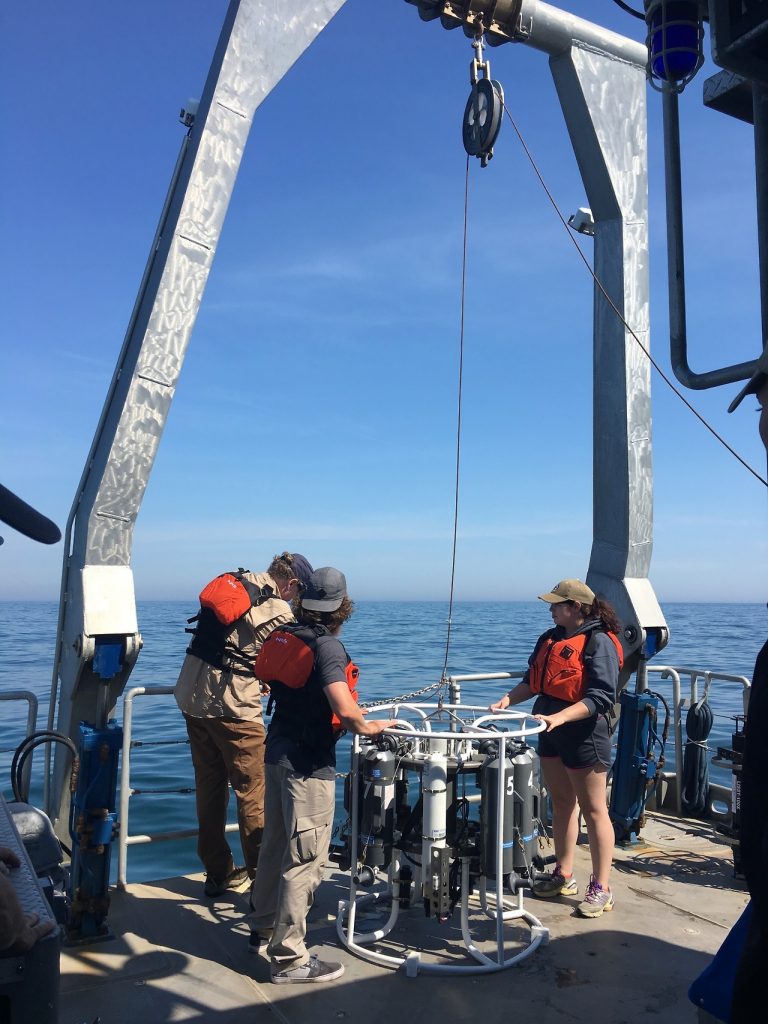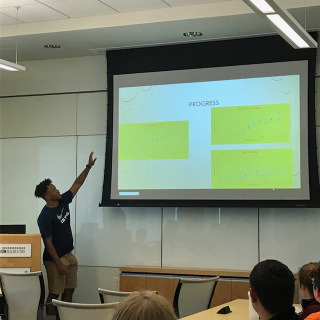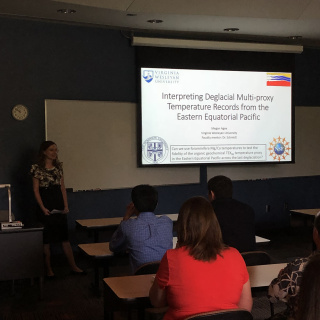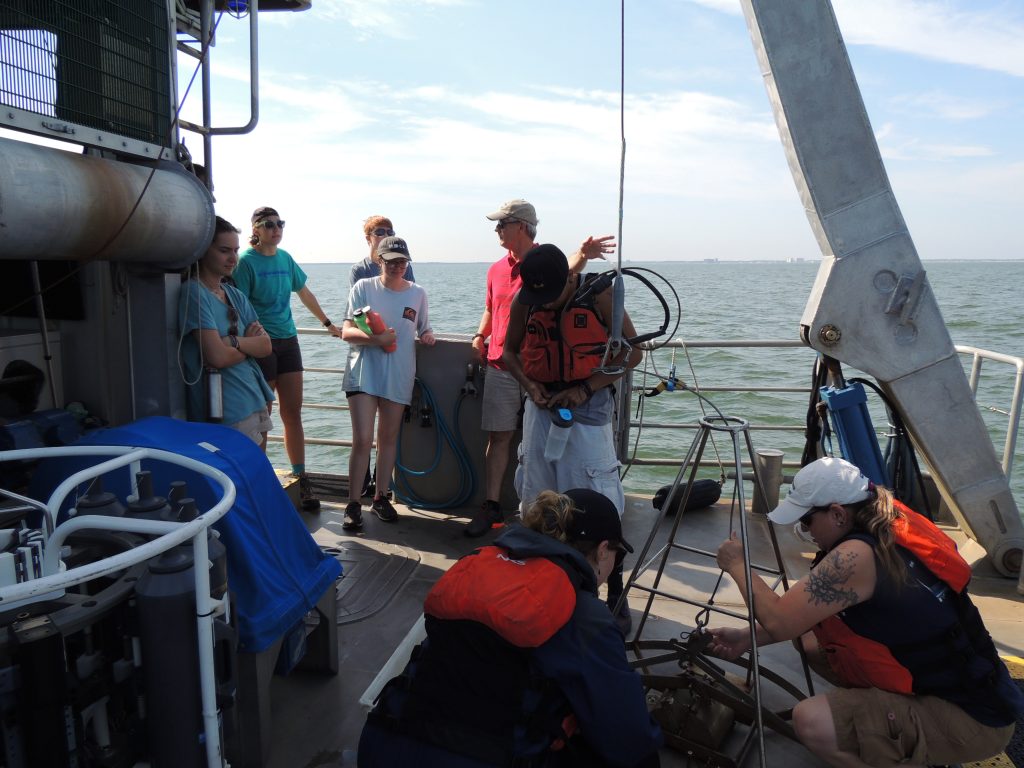Important Dates
—————————————————————————————————————
The program’s seminars, workshops, volunteering events, field trips, and deadlines are logged in the program’s Calendar (accessible by REU Staff, Mentors and Students). You can find the calendar here.
—————————————————————————————————————
- June 13th, 2019: Prospectus Presentations
- July 2th, 2019: Mid-Summer Progress Reports
- August 2nd, 2019: Final Presentations
R/V Fay Slover Cruise

The research cruise aboard ODU’s R/V Fay Slover is scheduled for June 18, 2019!
(Rain date June 12, 2019)
The goal of this cruise is to introduce REU students to oceanographic sampling at sea, while simultaneously collecting data for use in some REU Projects. We will be performing a “transect” of the Chesapeake Bay mouth, meaning we will be measuring and collecting samples along a straight from Cape Henry (the northern-most part of Virginia Beach) to the Chesapeake Light Tower (~25 miles off-shore; see photo below!). There is some important information you should know before getting onboard:
1) The R/V Fay Slover is docked at the NOAA Facility in downtown Norfolk. We will meet at the Oceanography Building’s parking lot and drive over as one. BRING YOUR ID! You will need it at the security checkpoint. We launch at 0800.
2) Make sure you wear/bring the following:
Clothes you don’t mind getting dirty (old T-shirt, gym shorts or jeans)
Close-toed shoes
Light jacket and other layers (it can get chilly!)
Sunscreen and sunglasses (hat is optional, but is encouraged)
Hair ties for long hair
Lunch!
3) It is HIGHLY recommended that you take either dramamine or bonine (non-drowsy variety of dramamine) beginning two days before the cruise and again 30 minutes before departure. The ship rocks quite a bit at sea, and there’s no turning back if anyone gets sea-sickness!
4) The cruise will be all day, so come prepared and have fun!
Project Prospectus
It’s time to show us what research you will be conducting this summer!
Students are expected to give a short (6 minute) oral presentation on the plans for your REU project and the research question they hope to address. This presentation marks the beginning of your summer research, so some gaps are acceptable and there will not be any results to share. Below are some format guidelines to follow as you prepare. Oral presentations will be held in CCPO Classroom on June 13th.
- Your presentations will be brief! We suggest a maximum of 1 minute per slide (i.e. no more than 6 slides), although fewer can be just as effective. Be clear and succinct. Use figures and graphics to describe your research question. Your target audience will be scientifically knowledgeable.
- Each talk should follow the general format below to include:
- Title Slide – include your name and mentor and one sentence science question.
- Background/Justification – what is your research questions or hypotheses. One slide.
- Methods – Maps of places you will work and methods as flow charts or organized lists as you know them.
- Plans for Data – What do you need for your summer research. Collections databases, etc. Can blend in with previous section.
- Summary/ Questions – what is the general goal?
- Timeline -Talk to your mentor and plan out your summer research! Be sure to set aside the final week (at least) for writing up your final paper. Use the shared Google Calendar (“Program Info” tab) to plan around scheduled seminars and workshops.
Any additional questions should be directed to the REU Staff. Good luck!

Mid-Summer Progress Report
This short oral presentation will give you a chance to share your progress to date and how you have addressed the initial research questions you presented in your prospectus. The presentation should build on your prospectus talk with any ongoing results and include plans for completion and synthesis. Oral presentations will be held on July 2nd. Below are some format guidelines to follow as you prepare:
1. You will have no more than 8 minutes for your power point (or Prezi) presentation. This means NO more than 8 slides; fewer can be just as effective. There will be 2-3 minutes for questions. Be clear and succinct. Use figures and graphics to describe your research question, ongoing results and hurdles, and plans. Your target audience will again be a scientifically knowledgeable audience.
2. The presentation should be based around what you have learned, samples collected, results to date and your plans for synthesis. Each talk should build upon your prospectus and include the slides below:
Title Slide – include your name, your mentor and project title/subject.
Background/Justification – Why is the broad research work important? One slide
Your Research Question(s) – What is your specific part of the larger research objective? Has this been revised from your original prospectus?
Methods – Maps and methods as flow charts or organized lists or bullet points. Pictures are ok for this as well. These should be more specific than your prospectus.
Progress to Date – Results if you have them.
Completion Plans – what is left to do. A slide on what remains to be done and what you have learned so far, remember to revisit your hypotheses. Did you answer the research question?
Summary and Questions.
Remember your presentations also be need to be saved as PDFs. We will send an email reminder prior to your presentations.
Final Presentation + Paper

Below is all the information you will need to write up your final results and present them to your peers at the conclusion of the summer program. Read them carefully!
Final Presentations:
This final oral presentation is your talk to a broad scientific audience and a chance to highlight how you have addressed your research topic over the last 10 weeks. The presentation should expand beyond your previous talk to provide final results, your synthesis and interpretation of what you have learned and what might be the next step on the research topic in the future. Below are some general format guidelines to follow as you prepare. Dress appropriately for a formal scientific presentation.
You will have no more than 10 minutes for your power point (or Prezi) presentation. This means NO more than 10 or 11 slides; fewer can be just as effective. There will be 3-4 minutes for questions from the audience. Use figures and graphics to describe your research question, how it was addressed during your summer and final results in the context of climate sciences. This is an open session with the campus invited and your target audience will include your mentors as well as other OEAS faculty, staff from the College of Sciences and members of the public.
This final presentation should summarize your research activities, the type of data collected or used, and how your results fit into the broader question of climate. Your talk should build upon your prior presentations and include the slides below and others you think appropriate. Remember that there will be many in the audience who have not heard you previously.
a) Title Slide – include your name, your mentor and project title/subject.
b) Background/Justification – What is the context of your research question, why is it important?
c) Specific goals for your Research – What is your specific part of the larger research issues presented in the background. Has your research question evolved during the summer?
d) Methods – Maps and methods as flow charts or organized lists of bullet points. Pictures are ok for this as well. These should reflect what was done.
e) Results and Interpretation – Data! This is a major part of your talk.
f) Summary – What do we know that we did not before
Oral presentations will take place on August 2nd, 2018
Remember your presentations also be needed as pdf copies to Shannon.
——————————————————————————————————-
Final Paper:
The general format of your final report will be as a scientific paper and as such should include all the major elements (abstract, introduction, methods, results, discussion, conclusion, acknowledgement and references). Since these reports are derived from data you have generated both individually and in many cases with others in your mentor lab, there needs to be some guidance as you prepare your report. Papers should follow standard scientific IMRAD style and be formatted as double spaced text in 11 point font with all pages numbered. Below are sections and guidelines you should follow.
The paper sections you should use:
Title – The title should be the same as you have used for your progress reports. With this title be sure and list your faculty mentor. If you have been working or assisted by graduate students this might be noted as well.
Abstract – One page or less. Your abstract should summarize the study and reiterate any quantitative results you have obtained.
Introduction – This should include needed references from the literature and provide an overview of your study and its context.
Methods – make sure all relevant measures are described in detail and properly referenced. Maps can be used and are useful to provide context. This should NOT simply be a figure of your workflow.
Results and discussion – This section provides the most critical information about your experiment and what you observed, measured or calculated. It should incorporate the broader results from the overall project, but primarily reflects your own efforts. These results then allow you to discuss how your hypothesis or research objective was or wasn’t supported.
Conclusions – This is a short paragraph which tell us the overall study outcome and what you learned. You can also make suggestions on what should be done to follow your work.
Acknowledgements – This short section allows you to note help or support. The first sentence of this should state “This study was funded by the National Science Foundation through the Research Experience for Undergraduate Program and the Department of Ocean, Earth and Atmospheric Sciences at Old Dominion University”. Then add others…
References – your references and readings to help describe your own specific results and their interpretation. Format should be standard scientific literature from a known journal.
Figures and Tables – These should help describe your samples, summarize results and provide comparisons with the work of others. They can be placed at the end or embedded in the text as you prefer. Be sure to have legends for both.
NOTE: Your final report should include as either primary or supplementary information access to ALL raw data generated as part of your project. This includes final figures and tables. Data you have used from others should be referenced if it is already published, or cited if pulled from a web site.
Content editing should be done between you and your advisor before submission of your final draft. Final papers are due by TBA. Be sure to email a copy to both Dr. Harvey and your academic advisor.
